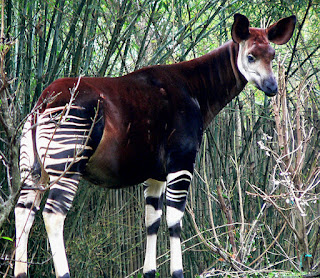Okapi
Okapi (Okapia johnstoni)
-------------------------------------
Etymology and Taxonomy
Scientifically, Okapi can be classified as:
Kingdom: Animalia
Phylum: Chordata
Class: Mammalia
Order: Artiodactyla
Family: Giraffidae
Genus: Okapia
Species: O. johnstoni
Phylum: Chordata
Class: Mammalia
Order: Artiodactyla
Family: Giraffidae
Genus: Okapia
Species: O. johnstoni
Okapi is an artiodactyl (an even-toed ungulate) mammal which is native to the Democratic Republic of the Congo, in Central Africa. It's markings are similar to zebras, but they're more related to giraffes because they belong in the family of Giraffidae. Okapi and Giraffe are the only surviving members of the Giraffidae until now.
Okapi is a medium-sized giraffid, standing 1.5m tall at the shoulder, with the average body length of 2.5m, and with the weight ranging from 200 to 350 kg. It has a long neck, and large flexible ears. The body coat is mostly brown, much contrast with the white horizontal stripes it has in it's legs.
While being in the same family as Giraffes, Okapis can be easily distinguished from their nearest relatives. It's much smaller and only males bear horns in Okapi.
The animal was named after the British Governor of Uganda, Sir Harry Johnston, who first acquired an okapi specimen.
Ecology and Behaviour
Okapis are primarily diurnal (does activities at the day, and sleeps at night) but may be active for a few hours in darkness. They live solitary, and only come together to breed. Male okapis tend to migrate continuously, while the females tend to stay where they are. Males mark their home ranges with their urine (averaging 13km^2) and females use common defecation sites (averaging 3-5km^2). The males are protective about their territory but allows female to pass through to forage. Males also visit female home ranges to breed.
Okapis are herbivores, feeding on tree leaves and buds, grasses, and other plants. They prefer to eat woody, dicotyledonous species.
Female okapis become sexually mature at about one and a half years old, while males reach their sexual maturity at two years old. The courtship begins by circling, smelling, and licking each other. The male shows dominance by extending his neck, and this is followed by copulation.
The gestational period for Okapis is around 440 to 450 days long. After birth, the mother extensively grooms the infant, and her milk is very rich in proteins and low in fat.
Habitat
Okapis inhabit canopy forests at altitudes of 500-1.500m. They are endemic to the tropical forests of the Democratic Republic of the Congo. A study found out that the population density of the okapi averaged 0.53 animals per square kilometre.
Threats and Conservation
The International Union for the Conservation of Nature and Natural Resources (IUCN) classifies the okapi as endangered. It is fully under protection of Congolese law. People hunt Okapis for their meat and for their skin. Another threat is habitat loss due to logging and human settlement. Now, many zoos in North America and Europe have Okapis in their captivity.
Q&A's
1. Which family does the Okapi belong to?
a. Giraffidae
b. Equidae
c. Rhinocerotidae
d. Monkeyidae
2. Okapis are endemic to the tropical forests of ...
a. Brazil
b. Sumatra Island
c. the Democratic Republic of the Congo
d. China
3. Female okapis become sexually mature at ...
a. 10 years old
b. 5 years old
c. 2.5 years old
d. 1.5 years old
4. The gestational period for Okapis are around ...
a. 440-450 days long
b. 365-380 days long
c. 123-156 days long
d. 500-600 days long
5. People hunt Okapis for their ...
a. skin and feather
b. skin and teeth
c. skin and meat
d. skin and nails
Sources and References
en.wikipedia.org
library.sandiegozoo.org/factsheets/okapi/okapi.htm
library.sandiegozoo.org/factsheets/okapi/okapi.htm
IUCN SSC Antelope Specialist Group (2008)
Sclater, Philip Lutley (1901). "On an Apparently New Species of Zebra from the Semliki Forest."
Nowak, Ronald M (1999) Walker's Mammals of the World. 6th ed. p. 1085.
Shaw, Albert (1918). "The African okapi, a beast unknown to the zoos".

Komentar
Posting Komentar